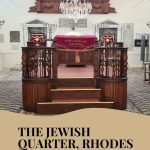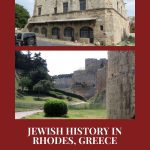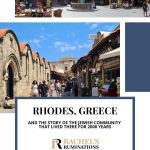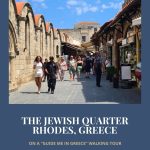The Jewish Quarter, Rhodes, Greece
Known for its medieval walled city of Rhodes and the ancient acropolis of Lindos, the island of Rhodes is home to another interesting piece of history: the story of the Jewish community that lived there for two thousand years.
Disclosure: I visited the Jewish Quarter in the Old Town of Rhodes as part of a sponsored walking tour provided by Guide Me in Greece. They have no influence over the content of this article – I just truly enjoyed it!
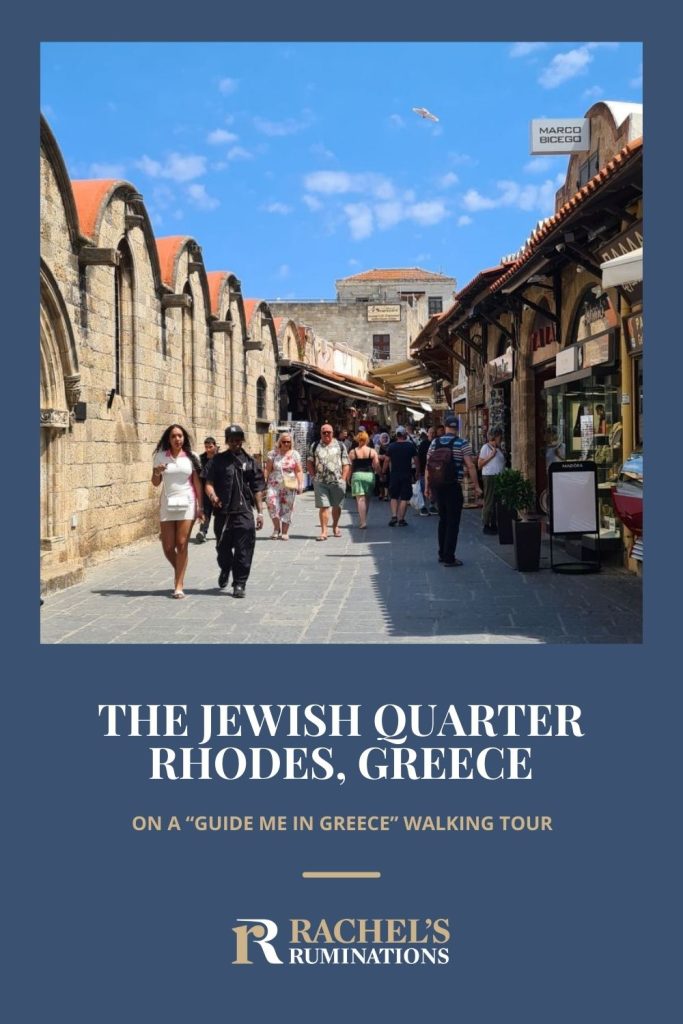
Another disclosure: This article contains affiliate links. Making a purchase through an affiliate link will mean a small commission for this website. This will not affect your price.
A brief history of the Jews of Rhodes
Jews have lived in Rhodes since the 2nd century BC. They likely came from the Middle East at first, and a group of Jews fleeing Aragon joined them after 1280 AD, when the island was under Arab rule.
Later, in 1480, when the Knights Hospitallers ruled the island, the Jewish community helped defend Rhodes against a Turkish attack and siege. Many were killed in the battles. After earthquakes hit in 1481-82 and destroyed what was left of the Jewish Quarter, many Jews left the island. For a while, only 22 Jewish families lived in Rhodes. (Read my article about the Knights Hospitaller period in Rhodes.)
Numbers grew soon after, however, when Jews were expelled from Spain in 1492, dispersing across Europe and the Americas. Some settled on Rhodes. They worked as shopkeepers, merchants and artisans for the most part. The women were known for the quality of their needlework.
The Jewish community’s relationship with the Knights Hospitaller shifted a number of times. Living outside of the walls, by order of the Knights, they lost their synagogue and much of the Jewish Quarter after the 1480 siege when the Knights expanded and reinforced the city’s walls. They were allowed to rebuild – inside the walls now – but then in about 1498 they were blamed for a plague and expelled.
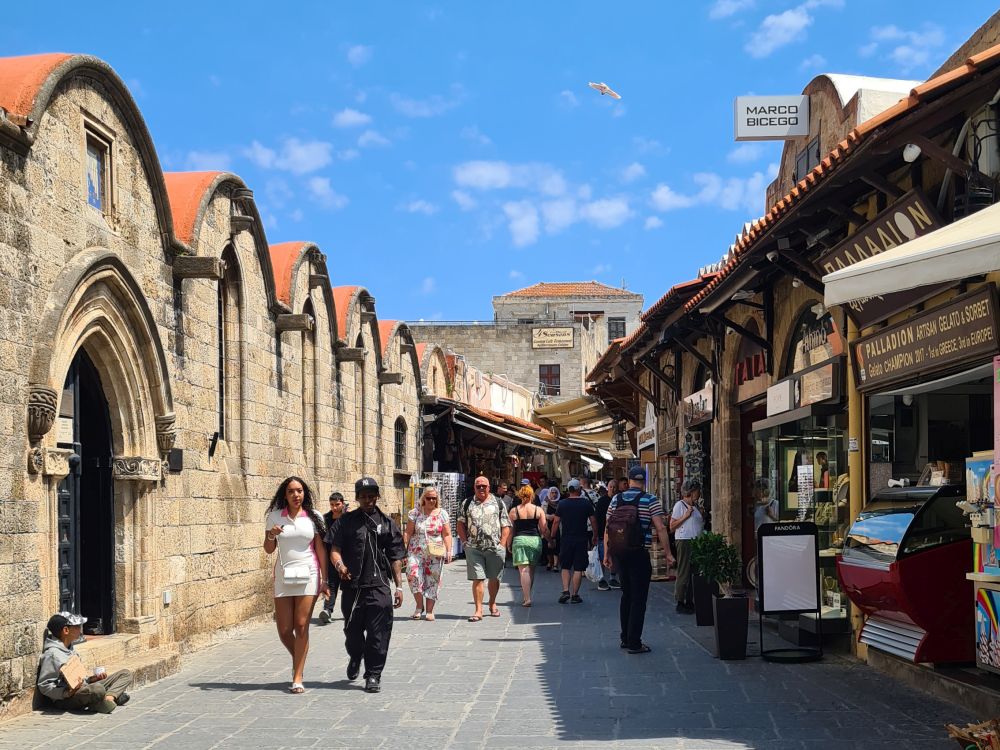
Many came back within the next few years to work on the fortifications, but you can understand why they might be reluctant to support the Knights anymore. That’s why they took the side of the Ottoman Empire when it attacked again in 1522, led by Suleiman the Magnificent.
After the Ottoman Empire conquered Rhodes, the Jewish community thrived and grew. The Ottomans allowed them to live in the city, within the defensive walls. The Christian community had to move outside.
Other Jews joined them on the island. Some were from Thessaloniki in Greece. Some were “crypto-Jews,” who had converted during the expulsion from Spain but remained Jewish in secret. Many Jews from within the Ottoman Empire migrated here too. At its height, the community had at least four synagogues, a rabbinical school and many yeshivas. They spoke Ladino, a language related to Spanish.
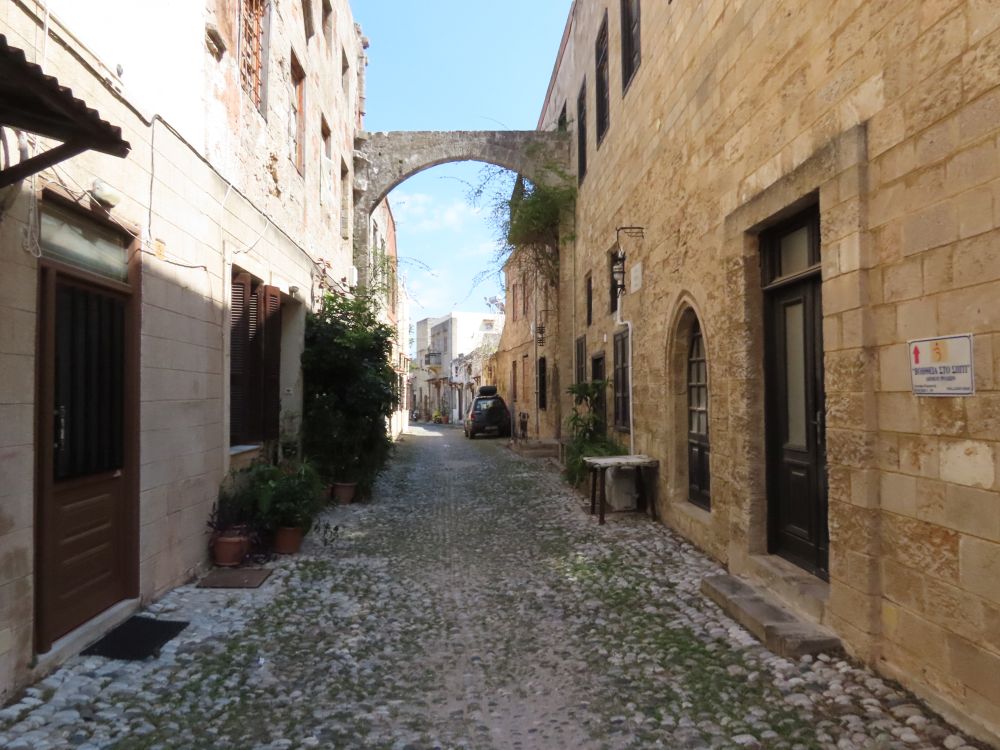
According to Wikipedia, there were 11,000 Jews on the island of Rhodes at the turn of the 20th century, out of a total of 28,000 population. Many left, though, both before and after the Italians took over the island in 1912, in search of better opportunities elsewhere. Some Italian, Bulgarian, Greek and Turkish Jews arrived during this period too. By 1930, there were only about 4,000 Jews. Things got harder as Mussolini enacted racial laws that restricted Jews’ civil rights, freedom of movement and so on. Half of the remaining Jews fled.
During World War II, the Jews who still lived on Rhodes were relatively unaffected; that is, until Italy surrendered to the Allies in September 1943. At that point, Rhodes came under Nazi rule. In July 1944, the Germans swiftly, in a matter of days, rounded up the entire Jewish community of 1,673 people. They transported them to Auschwitz: first a week on boats to Piraeus, then by cattle car across Europe to Poland. Only 151 of them survived the war.
Click to book accommodations in Rhodes. Or you can use the map below to find the perfect location in the Old Town or elsewhere on the island:
The Jewish Quarter walking tour
The Jewish Quarter that dates to the Ottoman Period is still pretty much intact within the city walls. However, there’s not much to mark it as specifically a Jewish quarter. That’s why I wanted to take a tour, and Guide Me in Greece was kind enough to offer my daughter and me a sponsored walking tour. While I could have found the remaining synagogue myself, I never would have spotted the other elements that our tour guide, Cristalla, showed us.
The synagogue of Rhodes
The only remaining active synagogue on the island was our first stop. The Kahal Shalom synagogue that exists today is not the original, but stands on the site where an earlier synagogue stood until the 1480 siege destroyed it. It was rebuilt in 1577 and has been renovated recently as well.
The main hall of the synagogue is in the Sephardic style. The place where congregants read the torah is on a platform in the center. The chairs face that, rather than all facing forward as in an Ashkenazi synagogue. The floor is a traditional Rhodian stone mosaic, beautifully restored.
An unusual feature is that there are two torah arks at the far end of the room, rather than the usual single one. They flank a door to outside. Our guide explained that this dates to when there were two different groups of Jews using the synagogue: the earlier arrivals, who were, to all intents and purposes, Rhodians; and the newer arrivals, mostly from Spain.
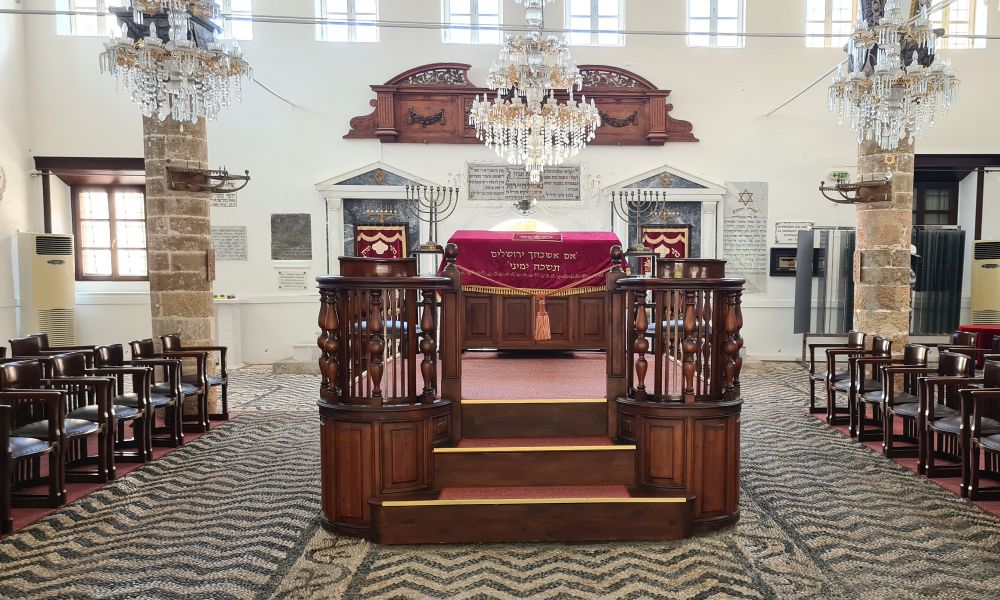
Today the synagogue is used occasionally when, for example, Jewish tour groups visit, or for events like weddings. What used to be the women’s section – in a Sephardic synagogue like this that is often a separate space to one side – is now a museum: the Jewish Museum of Rhodes.
Other sites in Rhodes related to the Jewish community
After we visited the synagogue and toured the attached museum, we knew the outlines of the history. Our guide led us around what was the Jewish Quarter under the Ottomans. Most of the points of interest that she showed us are not marked in any way, which is why it was so good to have a guide.
We started at Hippocrates Square, the tourist center of the old town of Rhodes. In the Ottoman period, Jews owned all these shops around the square.
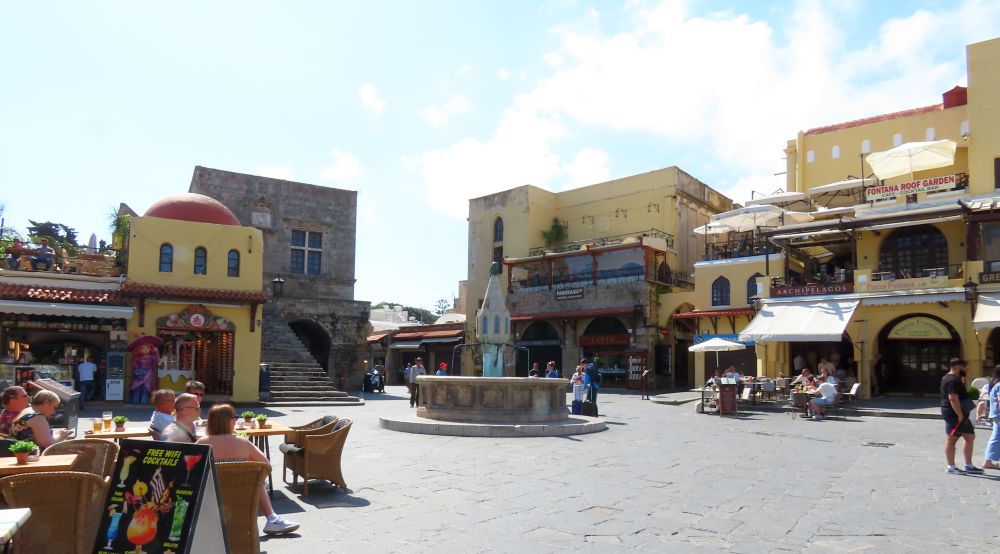
In the course of the tour, Cristalla pointed out the remains of several synagogues:
- One was more or less just foundations, unmarked.
- Another, the Romaniotes synagogue (1480), is now nothing but a large, intact tile floor, with the bases of some walls. A British bomb destroyed it in World War II.
- At another, the stairway up to the women’s section still stood, but not much else.
We saw a street that was and still is a pretty and quiet residential area. Some of the buildings have plaques naming the Jews who once lived there.
Nearby, the Elhadef Garden is now a park, but once belonged to a wealthy Jewish merchant named Elhadef. His family donated the land to the town.
Cristalla pointed out the building that was once the community’s rabbinical school.
We also walked a small part of the city’s moat. This was where the original Jewish cemetery used to be. When the Italians took over the island, they forced the community to move it to a different site further outside the city. They were able to save some of the tombstones, but the Italians took many to use as building material.
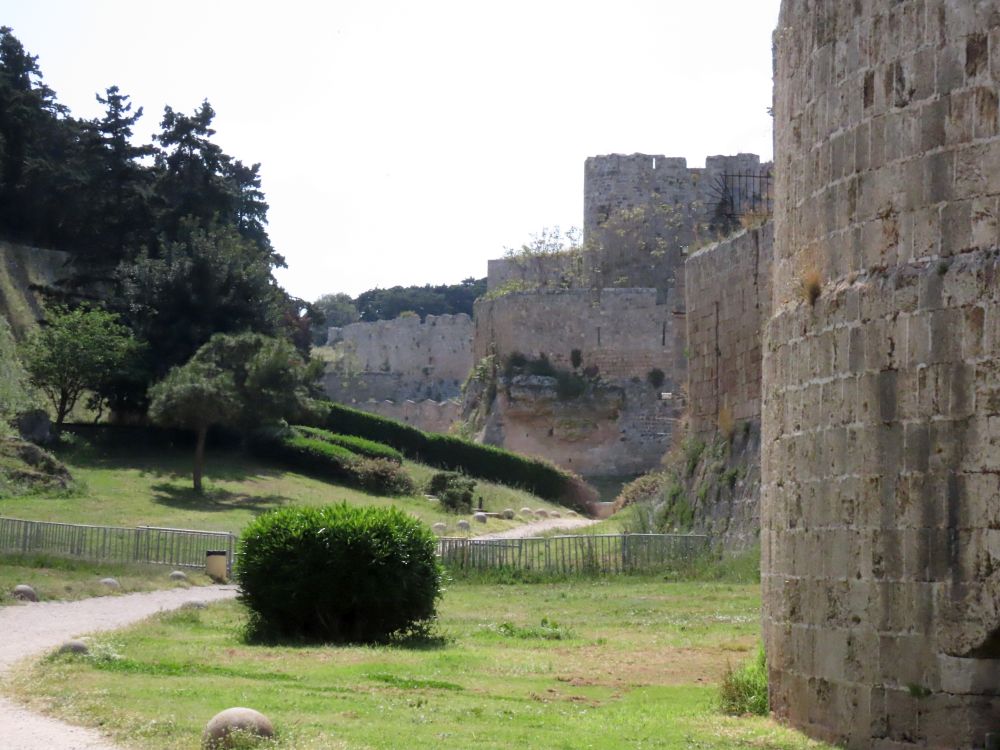
The Alliance Israelite Universelle ran a school starting in 1903 in the community. Its site is empty and overgrown now. We saw what used to be a fountain outside it, a gift from the Jews of Rhodes to thank the Alliance. It is now in disrepair and not functional.
A Jewish school was also one of the stops on the tour. In this case it is still intact, but is a general primary school. There are only a handful of Jews on the island nowadays, nowhere near enough to fill a school.
We finished the tour at the Holocaust memorial to the murdered Jews from Rhodes and Kos. It stands in a lovely and shady square called the Square of the Martyred Jews, surrounded by shops and cafes. The memorial is a black marble pillar with six sides. On each side is a statement in a different language: Greek, Hebrew, English, French, Italian and Ladino. It reads “In eternal memory of the 1604 Jewish martyrs of Rhodes and Cos who were murdered in Nazi death camps. July 23, 1944.”
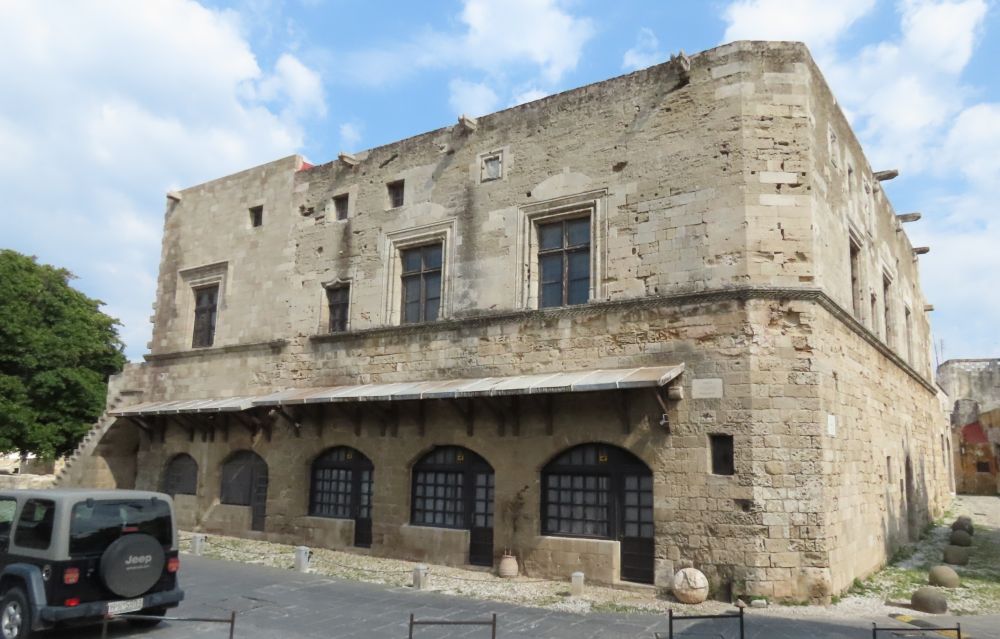
The Guide Me in Greece walking tour
Would I recommend this tour? Definitely! Cristalla clearly loves her island and knows all about it. She was enthusiastic and energetic, answering questions that were outside the topic of Jewish Rhodes as well as she answered questions about the Jewish community and its history. I also appreciated that, when she didn’t know something we asked, she didn’t just make something up as many guides will do. Instead, she tried to find the answer for us.
But the main reason I’d recommend taking this tour is that, despite how long this community lasted, most of the remaining traces of its 2000-year history are unmarked. Even for the ones that are visible, you’d really need to know where to find them. If you can’t sign up for a tour, at least go and visit the synagogue. You’ll learn the history of the Jews of Rhodes in the museum there.
Here is the link to book the Guide Me in Greece tour of the Jewish Quarter and synagogue. It’s a private tour, so it isn’t cheap, but especially if you’re traveling with a family or group, it’s worth it. They also offer a variety of other private tours all over Greece.
Have you been to Rhodes or do you have a connection to the Jews of Rhodes? Please leave a comment below!
My travel recommendations
Planning travel
- Skyscanner is where I always start my flight searches.
- Booking.com is the company I use most for finding accommodations. If you prefer, Expedia offers more or less the same.
- Discover Cars offers an easy way to compare prices from all of the major car-rental companies in one place.
- Use Viator or GetYourGuide to find walking tours, day tours, airport pickups, city cards, tickets and whatever else you need at your destination.
- Bookmundi is great when you’re looking for a longer tour of a few days to a few weeks, private or with a group, pretty much anywhere in the world. Lots of different tour companies list their tours here, so you can comparison shop.
- GetTransfer is the place to book your airport-to-hotel transfers (and vice-versa). It’s so reassuring to have this all set up and paid for ahead of time, rather than having to make decisions after a long, tiring flight!
- Buy a GoCity Pass when you’re planning to do a lot of sightseeing on a city trip. It can save you a lot on admissions to museums and other attractions in big cities like New York and Amsterdam.
Other travel-related items
- It’s really awkward to have to rely on WIFI when you travel overseas. I’ve tried several e-sim cards, and GigSky’s e-sim was the one that was easiest to activate and use. You buy it through their app and activate it when you need it. Use the code RACHEL10 to get a 10% discount!
- Another option I just recently tried for the first time is a portable wifi modem by WifiCandy. It supports up to 8 devices and you just carry it along in your pocket or bag! If you’re traveling with a family or group, it might end up cheaper to use than an e-sim. Use the code RACHELSRUMINATIONS for a 10% discount.
- I’m a fan of SCOTTeVEST’s jackets and vests because when I wear one, I don’t have to carry a handbag. I feel like all my stuff is safer when I travel because it’s in inside pockets close to my body.
- I use ExpressVPN on my phone and laptop when I travel. It keeps me safe from hackers when I use public or hotel wifi.



